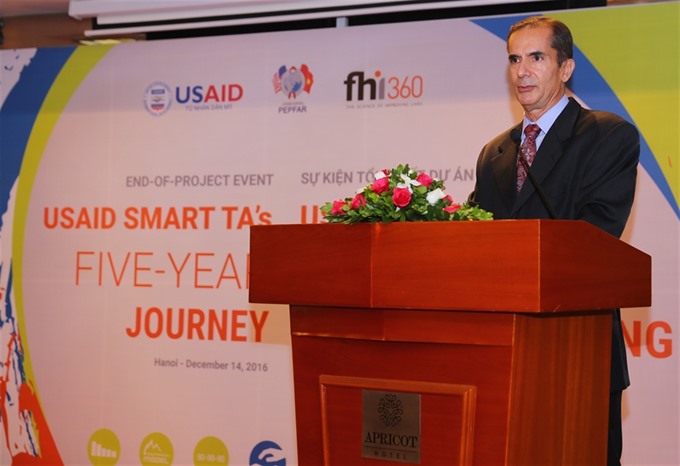 Society
Society

More than 280,000 people have received free HIV tests and 15,000 patients were newly enrolled for anti-retroviral treatment over the last five years.
 |
| More than 280,000 people have received free HIV tests and 15,000 patients were newly enrolled for anti-retroviral treatment over the last five years. — Photo daidoanket.vn |
HÀ NỘI — More than 280,000 people have received free HIV tests and 15,000 patients were newly enrolled for anti-retroviral treatment over the last five years.
A conference held yesterday in Hà Nội to wrap up a national project on sustainable management of HIV/AIDS response also heard that nearly 19,000 people injecting drugs have been given methadone treatment this year.
This accounted for 20 per cent of total methadone treatment patients in the country.
The US$45 million, five-year (2011-2016) project on Sustainable Management of HIV/AIDS response and Transition to Technical Assistance (SMART TA) was funded by the US President’s Emergency Plan for Aids Relief.
In its final year alone, the project provided treatment to more than 23,000 people living with HIV, the conference heard.
The project was implemented by the US Agency for International Development (USAID) in 11 provinces.
USAID Vietnam Mission Director Michael Greene said that Việt Nam has achieved great results in HIV response in recent years.
The response increasingly relies on local resources such as health insurance; and national and provincial funding have become key support sources, he noted.
The project has also helped integrate HIV services into the curative health system where facilities can be reimbursed through social health insurance, he said.
HIV patients in northern Điện Biên and central Nghệ An provinces were the first to receive social health insurance reimbursement for HIV services.
Nguyễn Tố Như, deputy chief of the project, said that one of the achievements of the project was its work in mountainous areas, where many people cannot access health services because of the long distance between their houses and local health clinics.
The project provided mobile laboratories to provide HIV tests for people in mountainous areas, and results were provided in 24 hours instead of the usual week.
She cited Quế Phong and Quỳ Châu districts in central Nghệ An Province as examples. After establishing mobile and satellite laboratories in these localities, as many as 500 at-risk people in Quế Phong District and more 300 in Quỳ Châu District have been tested.
Phan Thị Thu Hương, deputy director of Vietnam Authority of HIV/AIDS Control, said that after five years of implementing the project, the number of newly-infected people in HCM City has reportedly not reduced.
In the 2011-2015 period, HIV infections through sexual transmission accounted for 57.5 per cent and blood transmission was 41.3 per cent.
She said it was necessary to strengthen preventive work, and ensure that at least 90 per cent of patients knew their status, 90 per cent of those who knew their status were on treatment and 90 per cent of those on treatment were virally suppressed. These targets would help country could stamp out the HIV epidemic by 2030, she said.
As international donors have begun phasing out assistance, health insurance for people living with HIV/AIDS has become crucial for prevention, testing and providing anti-retroviral (ARV) treatment, health officials say.
The AIDS response overall is funded mainly by international donors who provide 70 to 80 per cent of all funds.
Some aspects of the response, particularly ARV treatment, are fully funded by donors.
Coverage of HIV treatment by the national health insurance scheme is crucial to increasing domestic funding of the AIDS response, as external funding will come to an end next year, they add.
Only 40 per cent of people living with HIV have health insurance, according to a report released by the Ministry of Health.
Most people living with HIV are poor, many of whom are without a permanent residence or a stable job with health insurance, said Nguyễn Hữu Hưng, deputy director of the HCM City’s Department of Health.
As ARV treatment has been made available free of charge due to international donor support, people living with HIV have found it unnecessary to purchase health insurance.
HIV-related stigma and discrimination remain significant barriers to providing health insurance coverage to infected people.
Many people living with HIV are afraid of their condition being made known to the public and refuse to join a health insurance scheme, Hưng said.
Nearly 50 per cent of people living with HIV in HCM City are covered by health insurance, but very few use the insurance cards for health exams because of anxiety about discrimination.
The number of people living with HIV in the city is estimated at 41,000, with nearly 28,000 people under ARV treatment, he said.
It is estimated that ARV treatment costs VNĐ12,000-24,000 for ARV treatment per person per day.
The financial burden of treatment costs could hinder access to ARV treatment for poor, uninsured people living with HIV, he added.
According to the HIV/AIDS Prevention and Control Department, ARV treatment costs around VNĐ420 billion ($18.58 million) per year.
The Prime Minister has ordered local authorities to create the most favourable conditions for all people with HIV/AIDS to join the national health insurance scheme.
Local health sectors have been asked to sign contracts with health insurance agencies to ensure benefits for insured people with HIV/AIDS.
Insured people living with HIV/AIDS will enjoy full payment for ARV treatment from health insurance agencies and the local State budget.
The number of people living with HIV is estimated at 230,000 in Việt Nam. A total of 8,059 people were diagnosed with HIV infection nationwide in the first 10 months of the year. – VNS




